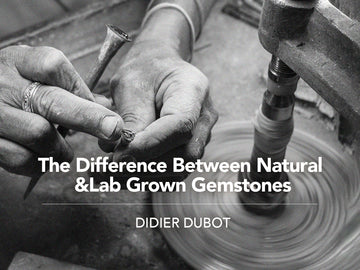Nothing beats the captivating scintillation of a gemstone. These treasures have been cherished for their beauty and rarity for thousands of years, used as both decorative objects and meaningful emblems. Gemstones traditionally come from the earth, but modern technology has allowed jewelers to create their very own versions in controlled settings. Although lab grown gemstones have been around for years now, many people still find them a mystery. Below we’ll explore the difference between natural and lab grown gemstones, so that you can figure out which variety suits you best.
What Are Natural Gemstones?
Natural gemstones are exactly what they sound like: they form within the earth, and can only be extracted through mining. Gemstone formation is a complex process that can sometimes take millions of years. It involves a combination of extreme heat, pressure, and chemical reactions deep within the earth’s crust. This intricate process makes gemstones rare and valuable, especially varieties that can only be found in specific locations. Natural gemstones tend to have more unique appearances, with inclusions and variations that will only show up in individual gems.

The Benefits Of Natural Gemstones
- Rarity and uniqueness. The natural formation of mined gemstones make them more difficult to obtain.
- Investment potential. Natural gemstones are often considered investment pieces due to their high value.
- Emotional value. Some people may feel a special connection with a gemstone because of its symbolism, or because it comes from a specific location.
- Historical significance. Many natural gemstones hold a strong cultural or historical significance. For example, diamonds are associated with enduring love and are the most popular choice for engagement rings.
- Natural beauty. Natural gemstones have distinct characteristics, variations, and inclusions that give them character and individuality.
- If natural gemstones are mined responsibly and sustainably, they are not harmful to the environment.
What Are Lab Grown Gemstones?
As the name suggests, lab grown gemstones are created in a laboratory. They are formed by replicating the conditions that form natural gemstones, and can be grown in a fraction of the time it takes for a natural gemstone to form. This tends to make the gemstones more affordable, sustainable, and accessible.

The Benefits of Lab Grown Gemstones
- Environmentally-friendly. Perhaps the biggest advantage of lab grown gemstones is their sustainable formation. Mining natural gemstones can cause a lot of harm to the environment through landscape destruction, water contamination, soil erosion, and habitat loss.
- You can rest assured that a lab grown gem was not created using the unethical labor practices often associated with mining.
- Not only does mining take a toll on the earth, it can drive up the cost of jewelry because of additional labor costs. Lab grown gemstones are often less expensive than natural gemstones because they can be created in large quantities and do not require the manpower of mining.
- Consistency & flawlessness. Lab grown gemstones can be made with a consistent color, clarity, and size. They also tend to have a flawless appearance, making them an ideal choice for those seeking perfection.
- Advanced technology allows lab grown gems to be grown to precise specifications, including colors and sizes that aren’t always available naturally. They’re a fantastic choice for bespoke or alternative designs that aren’t often found in traditional jewelry designs.
- Lab grown gemstones can be made in large, readily available quantities. This makes it easier to find certain gemstones that can be hard to find in nature.
Are Lab Grown Gemstones Real?
Absolutely! Although they were formed in different circumstances, they are still real gemstones. Lab grown varieties have the exact same chemical composition and are created using the same conditions; the process is just sped up and more controlled. An untrained eye will not be able to tell the difference.

Lab grown gemstones should not be confused with simulated gemstones, which have a different composition to both natural and lab-grown varieties. Simulated gems are made from other materials, such as glass, and are designed to look like a specific gemstone.
Natural Gemstones vs Lab Grown Gemstones
So, are there any other differences between natural and lab grown gemstones besides their origins? In terms of appearance, natural gemstones tend to have more inclusions, blemishes, and imperfections. Some people love these slight flaws as they create a more organic appearance, while others prefer the perfection of lab grown gems.
Another major difference is price. Natural gemstones tend to be more expensive than lab grown. While some people prefer the prestige of natural gems, many appreciate the accessibility of lab grown.
Is one better than the other? Not necessarily. It all comes down to personal preference, values, and budget. Whether you choose natural or lab grown, you’ll be left with a stunning gemstone that reflects your personality!
Writer: Maria Polansky











